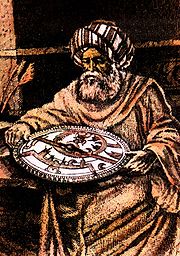- Albatenius
-
Mohammed ibn Dschābir al-Battānī oder Abū ʿAbdullāh Muhammad ibn Dschābir ibn Sinān al-Harrānī as-Sābī al-Battānī, أبو عبد الله محمد بن جابر بن سنان الحراني الصابي البتاني, DMG Abū ʿAbdullāh Muḥammad ibn Ǧābir ibn Sinān al-Ḥarrānī aṣ-Ṣābī al-Battānī, latinisiert Albategnius oder Albatanius (* etwa zwischen 850 und 869 in Harran nahe Şanlıurfa - heute Türkei; † 929 auf der Reise von Bagdad nach Raqqa in Qasr al-Dschiss (Samarra)) war ein arabischer Gelehrter und gilt als einer der größten Astronomen in Nahen Osten.
Al-Battânî vermittelte der arabischen Welt die Grundlagen der indischen Mathematik (Lehrbuch „Retha Ganita“: indische Ziffern, das Konzept der Null, Grundlagen der Geometrie und der Algebra). Durch die Araber weiterentwickelt gelangten diese Grundlagen später nach Europa.
Die astronomischen Tafeln Al-Battânîs wurden unter dem Titel Scientia Stellarum erstmals im Jahr 1537 in Nürnberg gedruckt.
Al-Battânî war Statthalter der Kalifen in Syrien. Seine astronomischen Beobachtungen hat er teils in Damaskus, teils in Aracta in Mesopotamien angestellt, weshalb er auch Mohammedes Aractensis heißt. Er berechnete die Länge des Sonnenjahrs auf 365 Tage 5 Stunden 46 Minuten 24 Sekunden, also bis auf rund zwei Minuten genau. Al-Battânî unterwarf die (scheinbare) Exzentrizität der Sonnenbahn einer neuen genauen Untersuchung und bemerkte dabei zuerst die Bewegung des Apogäums und berechnete die Bewegung der Planeten sehr genau. Weiterhin fügte er neue Tafeln und viele Modifikationen der herkömmlichen Theorie, des ptolemäischen Systems, hinzu. Bedeutend ist aber vor allem Al-Battânîs Verdienst um die Trigonometrie, in welcher er als erster statt der Sehnen den Sinus gebrauchte. Er fand und bewies als erster den Sinussatz.
Außerdem bewies er, dass das Verhältnis von Sinus durch Cosinus dem Tangens entspricht:
Er löste auch die Gleichung sin x = a cos x:
Weblinks
- The impact of Al-Battani on European Astronomy auf muslimheritage.com Besucht am 1. Mai 2008
- Al-Battani im MacTutor History of Mathematics archive (englisch)
- al-Battānī in der Britannica Online Encyclopedia
- Al-Batani. In: Brockhaus’ Konversationslexikon., 14. Aufl. 1893–1897, Bd. 1, S. 323
Personendaten NAME al-Battânî, Mohammed ibn Dschâbir ALTERNATIVNAMEN Al-Battânî; Albatenius (latinisiert); Albategnius (latinisiert); Mohammed ibn Dschābir al-Battānī; Mohammed ben Geber ben Senan Abu Abdallah al Batani; Abū ʿAbdullāh Muhammad ibn Dschābir ibn Sinān al-Harrānī as-Sābī al-Battānī; Abū ʿAbdullāh Muḥammad ibn Ǧābir ibn Sinān al-Ḥarrānī aṣ-Ṣābī al-Battānī KURZBESCHREIBUNG arabischer Gelehrter GEBURTSDATUM zwischen 850 und 869 GEBURTSORT Harran bei Şanlıurfa (heute Türkei) STERBEDATUM 929 STERBEORT Qasr al-Jiss (heute Irak) -
Wikimedia Foundation.




